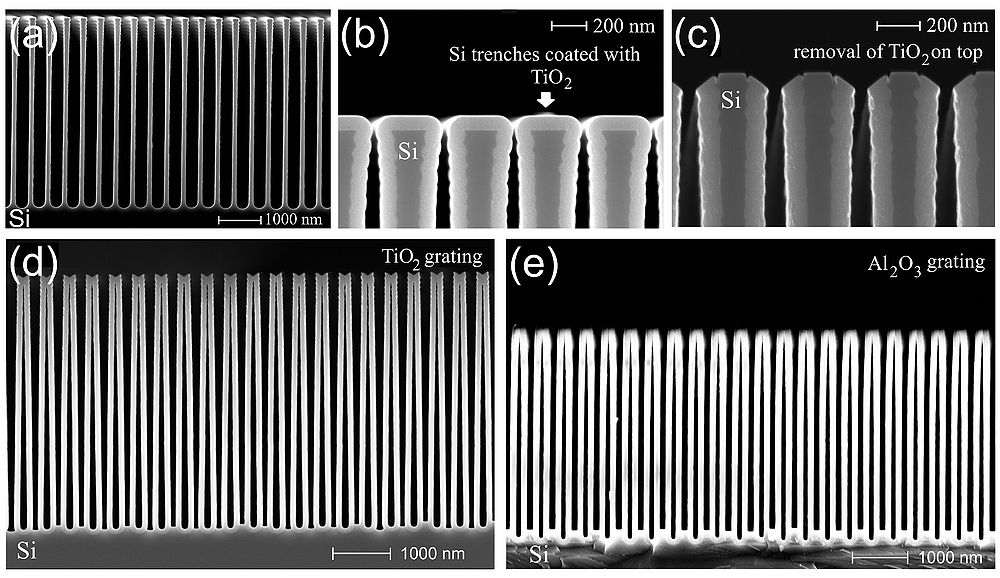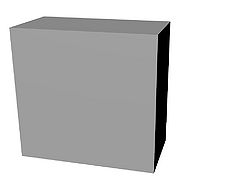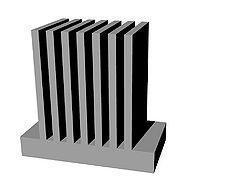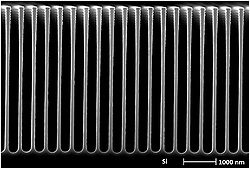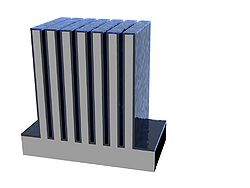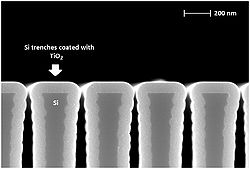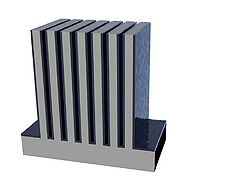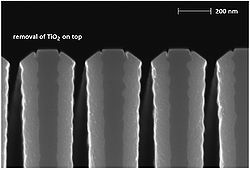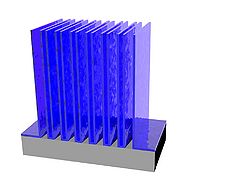LabAdviser/Technology Research/Fabrication of Hyperbolic Metamaterials using Atomic Layer Deposition/TIO ALU Gratings Procces flow: Difference between revisions
| Line 26: | Line 26: | ||
|- | |- | ||
! | !1.1 | ||
|Plasma surface treatment | |Plasma surface treatment | ||
|To ensure clean surface, the 100 mm Si wafer is treated by O<sub>2</sub>/N<sub>2</sub> plasma. (Optional step) | |To ensure clean surface, the 100 mm Si wafer is treated by O<sub>2</sub>/N<sub>2</sub> plasma. (Optional step) | ||
| Line 35: | Line 35: | ||
|- | |- | ||
|- style="background:#BCD4E6; color:black" | |- style="background:#BCD4E6; color:black" | ||
! | !1.2 | ||
|DUV Resist patterning | |DUV Resist patterning | ||
|DUV | |DUV | ||
| Line 43: | Line 43: | ||
|- | |- | ||
! | !1.3 | ||
|Deep reactive ion etching (DRIE) | |Deep reactive ion etching (DRIE) | ||
|DRIE | |DRIE | ||
| Line 52: | Line 52: | ||
|- | |- | ||
|- style="background:#BCD4E6; color:black" | |- style="background:#BCD4E6; color:black" | ||
! | !1.4 | ||
|Plasma surface treatment | |Plasma surface treatment | ||
|To ensure that remainings of DUV resist are gone, samples are treated by O<sub>2</sub>/N<sub>2</sub> plasma. (Optional step) | |To ensure that remainings of DUV resist are gone, samples are treated by O<sub>2</sub>/N<sub>2</sub> plasma. (Optional step) | ||
| Line 60: | Line 60: | ||
|- | |- | ||
! | !1.5 | ||
|Scanning Electron Microscopy inspection | |Scanning Electron Microscopy inspection | ||
|By cleaving the sample it is possible to inspect DRIE etched Si trenches in cross-sectional mode | |By cleaving the sample it is possible to inspect DRIE etched Si trenches in cross-sectional mode | ||
| Line 70: | Line 70: | ||
|- | |- | ||
|- style="background:#BCD4E6; color:black" | |- style="background:#BCD4E6; color:black" | ||
! | !1.6 | ||
|Atomic Layer Deposition of either Al<sub>2</sub>O<sub>3</sub> or TiO<sub>2</sub> | |Atomic Layer Deposition of either Al<sub>2</sub>O<sub>3</sub> or TiO<sub>2</sub> | ||
|Deposition carried at 150C.Thickness is 90 nm. | |Deposition carried at 150C.Thickness is 90 nm. | ||
| Line 79: | Line 79: | ||
|- | |- | ||
! | !1.7 | ||
|Scanning Electron Microscopy inspection | |Scanning Electron Microscopy inspection | ||
|By cleaving the sample it is possible to inspect ALD coatings deposited on Si trenches in cross-sectional mode | |By cleaving the sample it is possible to inspect ALD coatings deposited on Si trenches in cross-sectional mode | ||
| Line 88: | Line 88: | ||
|- | |- | ||
|- style="background:#BCD4E6; color:black" | |- style="background:#BCD4E6; color:black" | ||
! | !1.8 | ||
|Opening of deposited Al<sub>2</sub>O<sub>3</sub> or TiO<sub>2</sub> top layers. | |Opening of deposited Al<sub>2</sub>O<sub>3</sub> or TiO<sub>2</sub> top layers. | ||
|Etching happens using ICP Metal etcher with Cl<sub>2</sub>/BCl<sub>3</sub> process gasses. | |Etching happens using ICP Metal etcher with Cl<sub>2</sub>/BCl<sub>3</sub> process gasses. | ||
| Line 97: | Line 97: | ||
|- | |- | ||
! | !1.9 | ||
|Scanning Electron Microscopy inspection | |Scanning Electron Microscopy inspection | ||
|By cleaving the sample it is possible to inspect ICP etcher results Si trenches in cross-sectional mode | |By cleaving the sample it is possible to inspect ICP etcher results Si trenches in cross-sectional mode | ||
| Line 103: | Line 103: | ||
|[[image:TiO2_top_removal_nanogratings.jpg|250x350px|center]] | |[[image:TiO2_top_removal_nanogratings.jpg|250x350px|center]] | ||
|- | |- | ||
|- | |||
|- style="background:#BCD4E6; color:black" | |||
!1.10 | |||
|Selective etch of Si between ALD Al<sub>2</sub>O<sub>3</sub> or TiO<sub>2</sub> coatings. | |||
|Si etching proceeds using ICP Metal etcher with isotropic process based on SF<sub>f</sub> process gas. | |||
||Equipment used: [[Specific_Process_Knowledge/Etch/ICP_Metal_Etcher|Metal ICP Etcher]]. | |||
|[[image:00_zero (7)_nanogratings.JPG|250x350px|center]] | |||
|- | |||
|- | |- | ||
|} | |} | ||
<br clear="all" /> | <br clear="all" /> | ||
Revision as of 20:57, 31 May 2016
Procces flow description
The substrates for the samples were fabricated by depositing 1 μm of Si3N4 (the resonator layer) on 100 mm silicon < 100 > wafers using low-pressure chemical vapor deposition. The process was carried out at 780C with ammonia (NH3) and dichlorosilane (SiH2Cl2) as reactive gases. Thickness and refractive index of the deposited silicon nitride was measured and confirmed using spectroscopic ellipsometry. The deposited Si3N4 film was carefully analyzed for existence of cracks, particles and other defects using dark field optical microscopy. The best-quality wafer with Si3N4 was selected and cleaved in pieces, which were used as substrates for the deposition of Al2O3/TiO2 multilayers. Before inserting each substrate into the ALD reactor, it was placed on a Si carrier wafer. Therefore the Al2O3/TiO2 multilayers were grown not only on the Si3N4 layer but also on the dummy carrier wafer. After the ALD process was completed, the dummy was cleaved and its cross-section was characterized using scanning electron microscopy (SEM). The SEM images reveal high-quality homogeneous, conformal coatings, as seen in the examples in Figs 1. Such a method of deposited multilayers characterization turned out to be more feasible than the direct SEM characterization of multilayers on Si3N4, since the latter suffers from issues related to charge accumulation on the silicon nitride.
Process flow
Hej Evgeniy
Jeg har lagt dette eksemple på et process flow ind. Alt tekst og billeder skal selvfølgelig erstattes af relevante process steps for denne artikel.
Mvh. Berit
| Step | Description | LabAdviser link | Image showing the step | |
|---|---|---|---|---|
| 1.1 | Plasma surface treatment | To ensure clean surface, the 100 mm Si wafer is treated by O2/N2 plasma. (Optional step) | Plasma Asher 2 | |
| 1.2 | DUV Resist patterning | DUV | DUV Stepper Lithography. | |
| 1.3 | Deep reactive ion etching (DRIE) | DRIE | DRIE Pegasus. | |
| 1.4 | Plasma surface treatment | To ensure that remainings of DUV resist are gone, samples are treated by O2/N2 plasma. (Optional step) | Plasma Asher 2. | no image |
| 1.5 | Scanning Electron Microscopy inspection | By cleaving the sample it is possible to inspect DRIE etched Si trenches in cross-sectional mode | SEM Supra 2 | |
| 1.6 | Atomic Layer Deposition of either Al2O3 or TiO2 | Deposition carried at 150C.Thickness is 90 nm. | Equipment used: ALD Picosun R200. Standard recipes used: Al2O3T and TiO2T . | |
| 1.7 | Scanning Electron Microscopy inspection | By cleaving the sample it is possible to inspect ALD coatings deposited on Si trenches in cross-sectional mode | SEM Supra 2 | |
| 1.8 | Opening of deposited Al2O3 or TiO2 top layers. | Etching happens using ICP Metal etcher with Cl2/BCl3 process gasses. | Equipment used: Metal ICP Etcher. | |
| 1.9 | Scanning Electron Microscopy inspection | By cleaving the sample it is possible to inspect ICP etcher results Si trenches in cross-sectional mode | SEM Supra 2 | |
| 1.10 | Selective etch of Si between ALD Al2O3 or TiO2 coatings. | Si etching proceeds using ICP Metal etcher with isotropic process based on SFf process gas. | Equipment used: Metal ICP Etcher. | |
